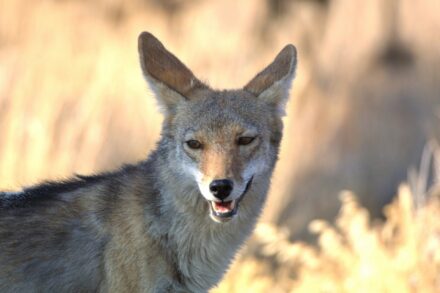DEC Issues Guidance to Avoid Coyote Conflicts
Sightings Anticipated to Become More Prevalent as Spring Approaches
The New York State Department of Environmental Conservation (DEC) today issued guidance to help prevent conflicts between people and coyotes. Coyote sightings are likely to increase in the coming months and DEC encourages New Yorkers to be aware of the potential for conflicts and follow DEC guidelines to prevent negative encounters.
Coyotes inhabit a variety of habitats throughout the state, from rural farmland and forests to populated suburban and urban areas. For the most part, coyotes will avoid human contact. However, conflicts with people and pets may occur, particularly during the spring denning and pupping period when coyotes tend to be more territorial and protective of pups. Furthermore, if coyotes learn to associate food, such as garbage or pet food, with people, these animals may lose their natural fear of humans, increasing the potential for close encounters or conflicts.
To reduce or prevent conflicts with coyotes, New Yorkers are encouraged to take the following steps:
- Never feed coyotes.
- Do not leave food outside. Pet food and garbage attract coyotes and other wildlife and increase risks to people and pets. DEC encourages people to:
-
- Feed pets indoors.
- Prevent access to garbage.
- Fence or enclose compost piles.
- Eliminate availability of birdseed. Concentrations of birds and rodents that come to feeders can attract coyotes.
- Do not allow coyotes to approach people or pets. If you see a coyote, be aggressive in behavior, stand tall and hold arms up or out to look as large as possible. If a coyote lingers for too long, make loud noises, wave arms and throw sticks and stones.
- Teach children to appreciate coyotes from a distance.
- Do not allow pets to run free. Supervise outdoor pets to keep them safe from coyotes and other wildlife, especially at sunset and at night. Small dogs and cats are especially vulnerable.
- Fence yards to deter coyotes. The fence should be tight to the ground, preferably extending six inches below ground level and taller than four feet.
- Remove brush and tall grass from around homes to reduce protective cover for coyotes as they are typically secretive and like areas where they can hide.
- Ask neighbors to follow these steps to prevent coyote conflicts.
In spring, coyotes tend to be more active and may be more visible. Just seeing a coyote occasionally is generally not a cause for concern. However, if they exhibit bold behaviors and have little or no fear of people, or if they are seen repeatedly during the daytime near residences, contact your Regional DEC Wildlife Office for assistance. In emergency situations, contact your local police department.
For additional information about the eastern coyote and preventing conflicts with coyotes, visit:
Posted: March 1st, 2023 under Adirondack Region News, Environmental News, General News, Law Enforcement News, State Government News.

